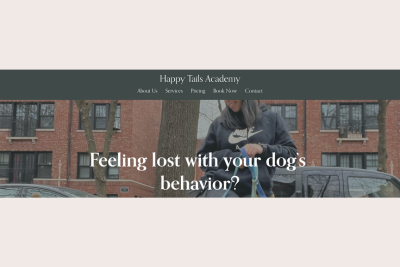Separation anxiety is a common issue that many pet parents face when leaving their dogs alone. It can be distressing for both the dog and the owner, but there are ways to address and manage this condition. In this blog post, we will delve into separation anxiety in dogs and discuss signs, common reasons, and steps to help dogs overcome it. We had the privilege of speaking with Ronnie, an expert in dog training and separation anxiety, to gain valuable insights into this topic.
You Might Be Interested In:
- How Happy Tails Academy Got Started – Interview with Ronnie
- FAQ For Dog Walking and Pet Sitting – Pricing and Payments
- Protecting Your Dogs Health During Poor Air Quality in Chicago
Understanding The Signs and Common Reasons for Dog Anxiety

Ronnie explains that dogs with separation anxiety often exhibit specific signs. Some common behaviors include pacing, whining, destructive chewing, vocalization (barking, howling, screeching), and elimination indoors, even if they are already potty trained. The key characteristic of separation anxiety is the persistence of these behaviors throughout the entire duration the dog is left alone. Unlike occasional destructive behavior, separation anxiety-related behaviors continue regardless of the length of time the dog is alone.

If you’re based in Chicago, we recommend Green Paws Chicago for compassionate, professional dog walking. They’re a trusted local service that helps your dog stay active and social even while you’re away.
(When signing up, don’t forget to mention Chicago Urban Pets to support the blog and help us continue creating helpful content.)
The Steps to Helping Dogs Overcome Separation Anxiety

Ronnie emphasizes the importance of a thorough intake session to gather information about the dog’s history and any potential triggers or factors contributing to their anxiety. This helps in formulating an individualized training plan. It also introduces Ronnie to your highly anxious pup in a more chill environment.
One crucial aspect of addressing separation anxiety is desensitization. Desensitization involves gradually exposing the dog to being alone in small increments, starting with short periods and gradually increasing the duration over time. This method helps the dog become more comfortable with being alone and reduces anxiety.
The Experience for Pet Parents and Setting Realistic Expectations
Ronnie highlights that providing clear expectations to pet parents is essential. Separation anxiety is a panic disorder for dogs, causing them to experience intense fear and distress when left alone. Overcoming this fear takes time and patience.
While the duration varies for each dog, Ronnie advises pet parents to be prepared for a long-term commitment of several months to a year. By understanding the slow process involved, pet parents can better support their dogs through the journey of overcoming separation anxiety.

Common Mistakes to Avoid

One common mistake Ronnie often encounters is the belief that letting a dog “cry it out” will eventually solve the problem. However, this method is not effective for separation anxiety. Dogs do not possess the same rational thinking as humans and cannot self-soothe or understand why they are left alone.
Allowing a dog to cry for extended periods can worsen their anxiety. Ronnie strongly advises against this approach and suggests alternative methods that focus on gradual desensitization.
How to Get in Touch with Ronnie From Happy Tails Academy

Ronnie’s expertise sheds light on the importance of individualized training plans, gradual exposure to alone time, and setting realistic expectations. By avoiding common mistakes and seeking professional guidance, pet parents can provide the support their dogs need to overcome separation anxiety and lead happier, more balanced lives.
To consult with Ronnie and learn more about separation anxiety training, visit the Happy Tails Academy website or contact Ronnie via email at happytailsacademy@outlook.com. Remember, patience and consistent effort are key when helping your furry friend overcome separation anxiety.

If you’re based in Chicago, we recommend Green Paws Chicago for compassionate, professional dog walking. They’re a trusted local service that helps your dog stay active and social even while you’re away.
(When signing up, don’t forget to mention Chicago Urban Pets to support the blog and help us continue creating helpful content.)

